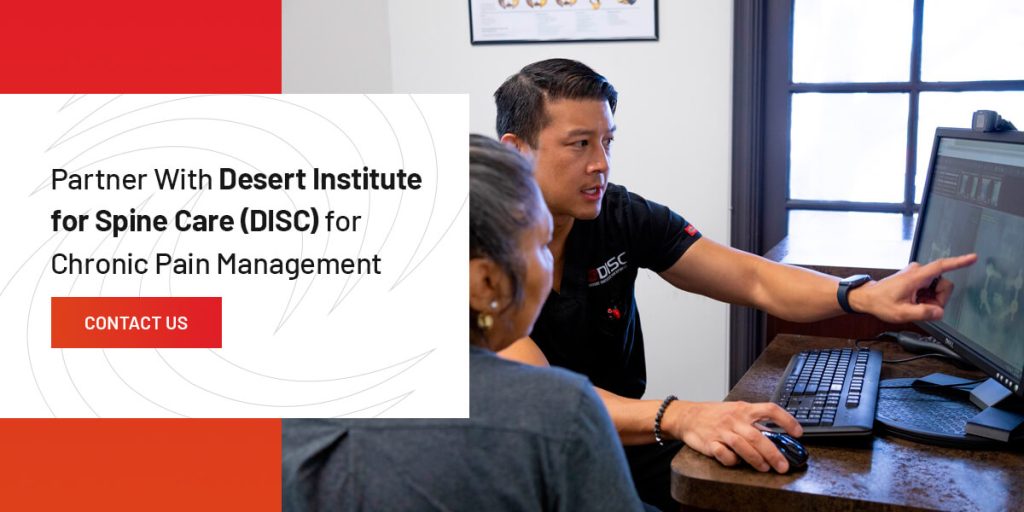
An annular tear is a discogenic condition that impacts the spine, causing lower back pain. Natural wear and tear, sports injuries, improper lifting and repetitive motions are the most common causes of annular tears, as the injury results from the fibers that make up the intervertebral disc breaking or separating.
While these tears can occur anywhere on the spine, they happen most often in the neck and lower spine, with pain ranging from mild to severe. Other symptoms can include weakness or numbness in the arms or legs and limited flexibility.
Annular tears are very common and often associated with low back pain, experienced by up to 84% of adults in the United States throughout their lifetime. Fortunately, there are many things you can do to manage pain if you have an annular tear. From physical therapy and exercise to minimally invasive procedures, here are a few ways you can find relief.
Your physician will begin by examining your spinal condition through an X-ray and/or magnetic resonance imaging (MRI). They will also ask you a series of questions about your health history, points of pain and specific concerns to determine the best course of action.
While larger annular tears will require treatment, a smaller one might heal on its own. However, keep in mind that once the area is torn, it’s more likely to tear again in the future. That’s why the best form of treatment is prevention — take care to avoid anything that could cause significant trauma along the spine, and work on strength-building exercises that target the upper and lower body and the core.
The first lines of treatment to manage pain and maintain mobility while a tear heals include:
The following annular tear exercises can help you build muscle strength, increase mobility and reduce pain:
While regular exercise can help reduce pain and aid in healing, you’ll want to avoid running, barbell squats, deadlifts and twisting exercises, as these carry a risk of aggravating your injury. A physical therapist will create a tailored exercise routine to help you heal and alleviate your pain as the tear mends.
If conservative treatment methods fail to address your pain, you might explore surgical annular treatment options. Your provider will help you choose the best surgery type for your condition and preferences. Options typically include:
Minimally invasive surgeries mean smaller incisions, shorter recovery times and reduced risk of complications. It’s important to discuss treatment options with licensed orthopedic surgeons, as they can determine whether you are the right candidate for an endoscopic discectomy.

It’s vital that you consult with experienced healthcare professionals to determine the right course of treatment for an annular tear. At DISC, our orthopedic surgeons offer various innovative treatments and always recommend the least invasive options first based on your specific condition and symptoms. Most clients can improve with conservative treatments like regular exercise, proper posture and physical therapy.
We can help you find the right lifestyle changes to minimize further tears and allow healing. We can also provide guidance on pain management medications, working with you to assist with healing and providing the best possible care. If conservative treatments don’t alleviate your pain within six to eight weeks, we can recommend minimally invasive surgery. Our team specializes in endoscopic spine surgery and can walk you through the surgery process to ensure you can make a fully informed decision.
Our innovative treatment options for disc tears include:
Experience the future of spinal care with Desert Institute for Spine Care’s revolutionary approach to treating disc tears. We use innovative technology and techniques to target disc tears with precision, minimizing discomfort and recovery time.

If you are dealing with low back pain, you’ll find various annular tear treatment options that can help you get relief. From regular exercise and physical therapy to minimally invasive procedures, managing pain and inflammation associated with annular tears is possible. Whether you require a surgical or nonsurgical option depends on the tear’s severity and your overall needs.
At DISC, we understand that spinal issues can be daunting, which is why we prioritize your well-being above all else. Our compassionate team of experts specializes in minimally invasive procedures designed to alleviate your pain and help restore your lifestyle. Our commitment to your comfort and safety ensures you receive the best care possible.
Look forward to a faster, less painful recovery and a brighter, pain-free future and request an appointment today. From minimally invasive procedures to the most complex spine surgery, we provide compassionate, innovative and effective treatments to improve your quality of life.